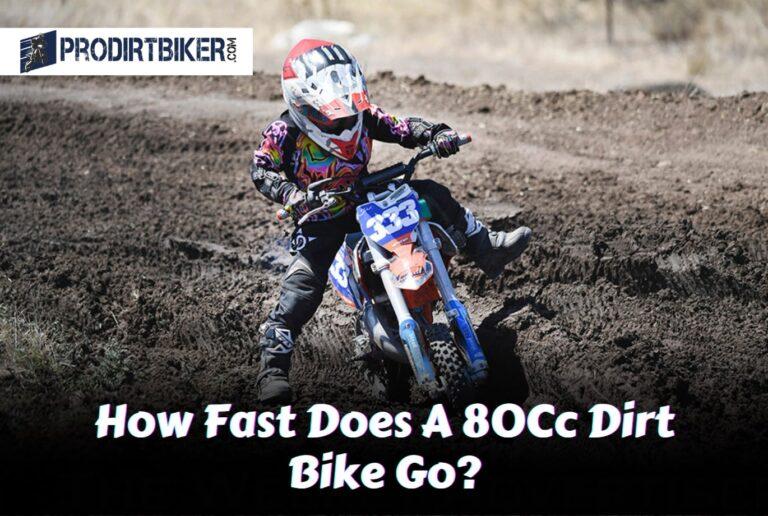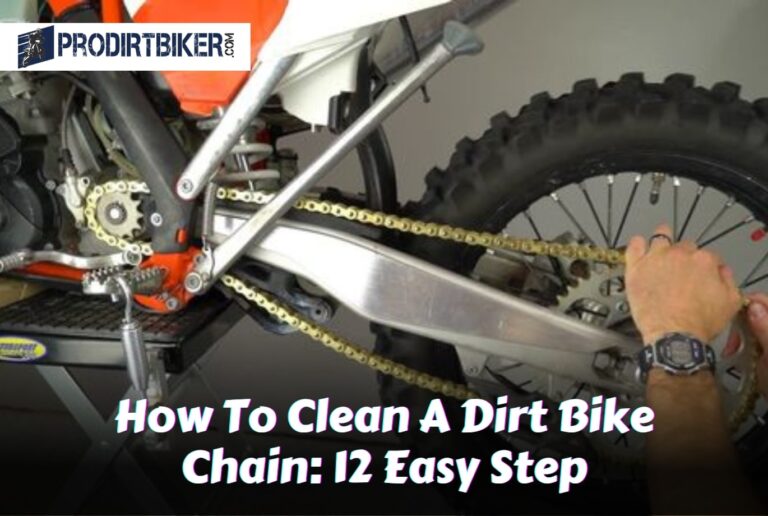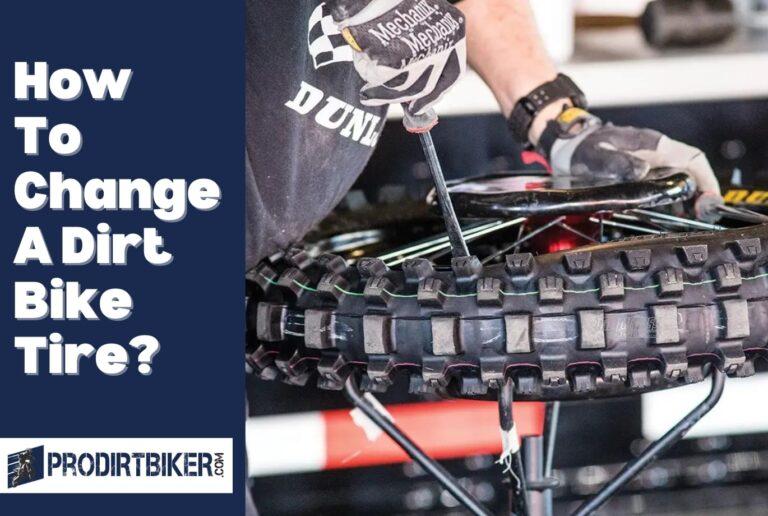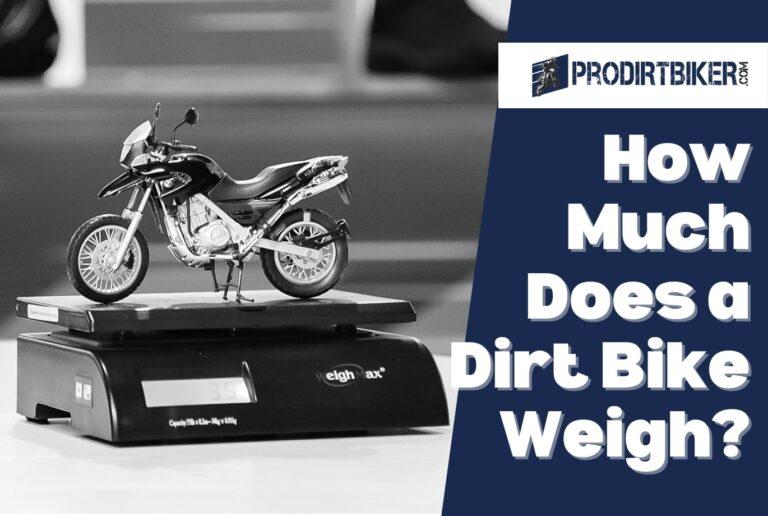How to Use a Clutch on a Dirt Bike? A Comprehensive Guide
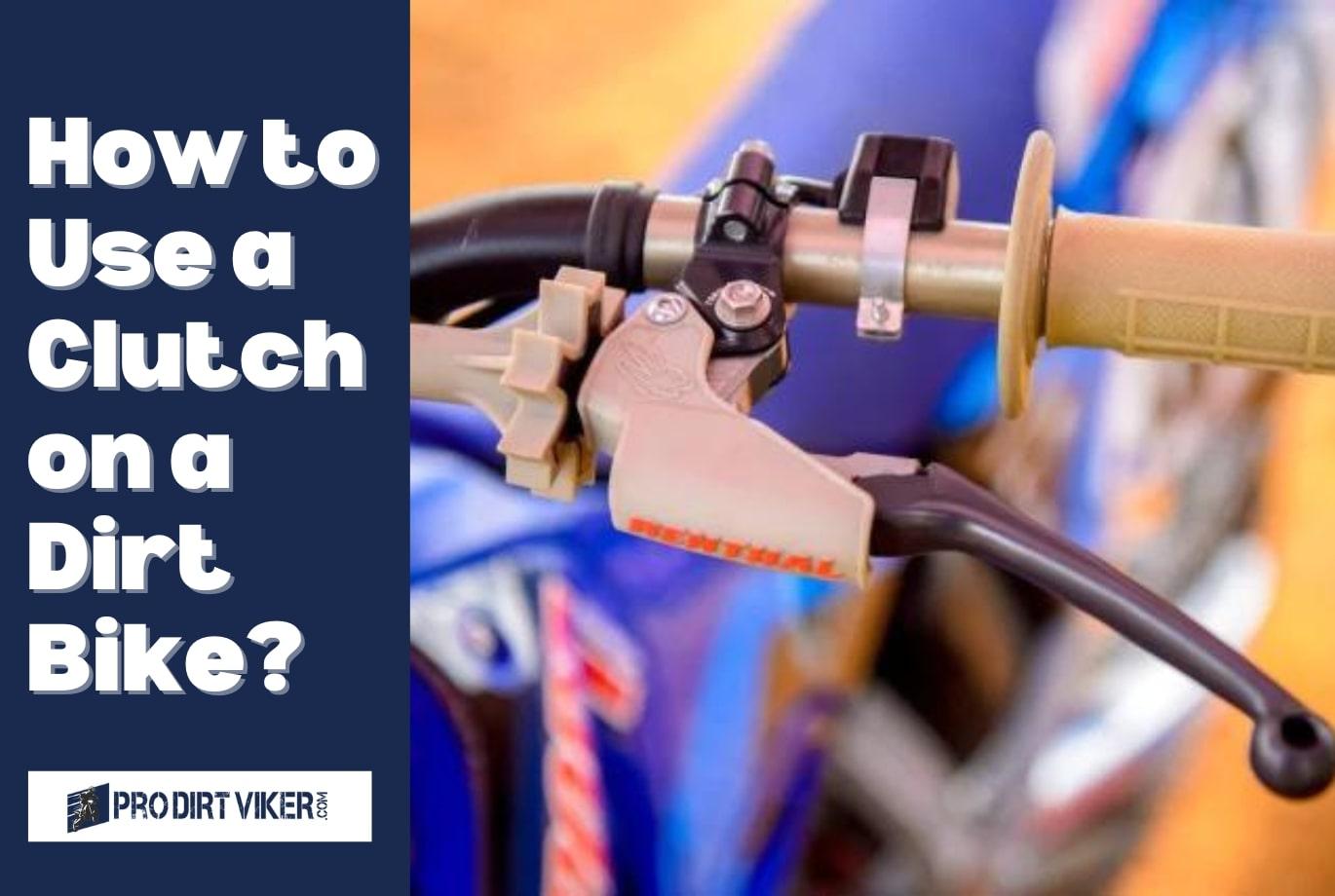
Learning how to properly use a clutch on a dirt bike is an essential skill for any rider, whether you’re just starting out or have been riding for years. Using the clutch correctly can greatly improve your control and maneuverability on the trails, allowing you to tackle obstacles with confidence and ease.
In this blog post, we’ll walk you through the step-by-step process of using a clutch on a dirt bike. We’ll cover everything from finding the friction zone to shifting gears smoothly. Whether you’re a beginner or looking to brush up on your skills, this guide has got you covered. So grab your helmet, hop on your bike, and let’s get started!
How to Use a Clutch on a Dirt Bike?
To use a clutch on a dirt bike, pull in the clutch lever with your left hand and shift the gear lever with your left foot. Riding a dirt bike requires a good understanding of how to operate its various controls, including the clutch.
Using a clutch on a dirt bike is an essential skill for effective control and maneuverability. Here’s a step-by-step guide on how to use a clutch on a dirt bike:
- Understanding the Clutch Lever:
- Locate the clutch lever on the left handlebar. It’s usually smaller than the brake lever and can be pulled towards the handlebar.
- Starting the Bike:
- Ensure the bike is in neutral by gently tapping down on the gear shifter until you can move it freely.
- With the clutch lever pulled in, start the bike. Many dirt bikes require the clutch to be engaged for starting.
- Shifting into First Gear:
- With the bike in neutral and the clutch lever pulled in, gently tap up on the gear shifter until you feel a slight resistance. This is the first gear.
- Partial Clutch Engagement:
- Squeeze the clutch lever in fully.
- Gradually release the clutch lever until you feel the bike start to move forward slightly. This is the friction zone, where the engine starts to engage with the transmission.
- Balancing Throttle and Clutch:
- While partially engaging the clutch, apply a small amount of throttle to keep the engine from stalling.
- Practice finding the right balance between releasing the clutch and applying throttle for smooth and controlled acceleration.
- Upshifting:
- As you gain speed, use your foot to tap the gear shifter upward to shift to higher gears.
- Each time you shift, you’ll need to briefly disengage the clutch by pulling the lever in.
- Downshifting:
- When slowing down, use your foot to tap the gear shifter downward to shift to lower gears.
- Again, briefly disengage the clutch with each downshift.
- Braking and Clutch:
- When coming to a stop, pull in the clutch lever to disengage the engine from the transmission.
- Apply the brakes as needed.
- Stopping and Shutting Off:
- When stopping the bike, pull in the clutch lever and shift down to first gear.
- If you’re coming to a complete stop, it’s a good practice to shift to neutral and then release the clutch.
- Practice:
- The key to mastering clutch control is practice. Start in an open, flat area and gradually introduce more complex terrain as your skills improve.
Remember that each dirt bike may have slight variations in clutch feel, so it’s crucial to spend time becoming familiar with your specific bike. Consistent practice will help you develop smooth and precise clutch control for better performance on the trail
Understanding The Clutch
Clutch control is an essential skill for anyone riding a dirt bike. Whether you’re a beginner or an experienced rider, understanding how the clutch works is crucial for maintaining control and getting the most out of your bike. In this section, we will delve into the mechanics of a dirt bike clutch and its role in power transfer.
What Is A Clutch And How Does It Work?
A clutch is a mechanical device that connects and disconnects the engine’s power to the rear wheel of a dirt bike. It allows the rider to control the transfer of power from the engine to the drivetrain. When the clutch lever is engaged, the clutch plates are pressed together, connecting the engine’s power to the transmission.
When the lever is disengaged, the clutch plates separate, disengaging the power transfer.
Components Of A Clutch System In A Dirt Bike
To better understand how a clutch works, let’s take a look at its key components:
- Clutch lever: The lever located on the handlebars that controls the engagement and disengagement of the clutch.
- Clutch plates: A set of alternating metal plates and friction plates that are sandwiched together. When the clutch lever is engaged, they are pressed together to transfer power. When disengaged, they separate.
- Clutch basket: A cylindrical housing that holds the clutch plates. It is connected to the engine’s crankshaft.
- Pressure plate: The plate that applies pressure on the clutch plates to engage the power transfer.
- Springs: These provide the necessary tension to keep the clutch engaged.
The Role Of The Clutch In Controlling Power Transfer
The clutch plays a vital role in controlling the power transfer from the engine to the drivetrain of a dirt bike. Here’s how the clutch helps in maintaining control:
- Smooth starts: By partially engaging the clutch, riders can slowly and smoothly take off from a standstill, preventing the bike from stalling.
- Gear changes: When shifting gears, the clutch needs to be disengaged to temporarily disconnect the engine’s power and facilitate smooth gear changes.
- Controlling speed: By modulating the clutch lever, riders can effectively control the speed of the bike, especially in low-speed maneuvering and technical sections.
- Stopping and idling: Engaging the clutch fully disengages the power, allowing the bike to idle or come to a complete stop without stalling the engine.
Understanding the mechanics and role of the clutch in a dirt bike is crucial for mastering clutch control. In the next section, we will further explore how to effectively use the clutch while riding off-road. So, stay tuned!
Step 1: Familiarizing Yourself With The Clutch Lever
Locating The Clutch Lever On Your Dirt Bike
When it comes to using a clutch on a dirt bike, one of the first things you need to familiarize yourself with is the clutch lever. This lever is a vital component that allows you to control the engagement and disengagement of the clutch while riding.
Located on the left handlebar of your dirt bike, the clutch lever is easily accessible and operated with your left hand. Now let’s delve into understanding the different positions and functions of the clutch lever.
Understanding The Different Positions And Functions Of The Clutch Lever
To effectively use the clutch on your dirt bike, it’s essential to comprehend the various positions and functions of the clutch lever. Here are the key points to keep in mind:
- The resting position: When you release the clutch lever fully, it returns to its resting position. This position ensures that the clutch is fully engaged, allowing power from the engine to transfer to the rear wheel.
- The engaged position: By squeezing the clutch lever towards the handlebar, you disengage the clutch, interrupting the power transfer. This position is used when you need to change gears or come to a stop.
- The friction zone: Between the resting and engaged positions lies the friction zone. This area allows for a gradual engagement of the clutch, providing smooth power delivery and control over the bike’s acceleration. It is crucial to become familiar with this zone to achieve a seamless riding experience.
Popular Post:
Adjusting The Clutch Lever To Suit Your Riding Style
Every rider has their own unique riding style, and adjusting the clutch lever to match your preferences can greatly enhance your dirt bike experience. Here are a few tips to help you achieve the perfect adjustment:
- Lever reach: Many dirt bike models offer an adjustable clutch lever to accommodate riders with different hand sizes and preferences. Adjust the lever reach by loosening the adjustment screw and finding a comfortable distance between the lever and the grip.
- Lever angle: Experiment with the lever angle to find the position that allows for a natural and comfortable grip. The lever should align with the natural motion of your fingers when pulling it towards the handlebar.
- Tension: Ensure that the tension of the clutch lever is not too loose or too tight. You should be able to easily squeeze the lever without strain, but it should not engage unintentionally when riding over rough terrain.
By familiarizing yourself with the location, functions, and adjustment of the clutch lever on your dirt bike, you’ll be well on your way to mastering the art of clutch control. So, hop on your bike, practice these steps, and get ready to take your riding skills to a whole new level!
Step 2: Proper Hand Placement On The Clutch Lever
Riding a dirt bike can be an exhilarating experience, but mastering the use of the clutch is crucial for a smooth and controlled ride. In this step-by-step guide, we will take a closer look at the proper hand placement on the clutch lever to ensure optimal control and performance on your dirt bike.
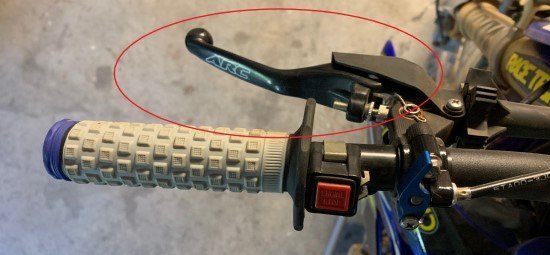
The Correct Hand Grip For Clutch Control
When it comes to operating the clutch lever on your dirt bike, having the correct hand grip is essential. Here are the key points to keep in mind:
- Position your hand on the handlebar grip, ensuring a firm and secure grip.
- Place your index and middle fingers on the clutch lever, with your other fingers wrapped around the handlebar grip.
- Maintain a slight bend in your elbow to allow for fluid movement of your hand.
Positioning Your Fingers On The Clutch Lever
Ensuring proper finger placement on the clutch lever is vital for quick and efficient clutch control. Consider the following tips:
- Position the base of your index and middle fingers on the clutch lever, near the pivot point.
- Avoid gripping too tightly, as it can lead to fatigue and reduced control.
- Keep your fingers curled around the lever, ready to engage or disengage the clutch with precision.
Ensuring A Comfortable And Secure Grip While Riding
While riding your dirt bike, it’s important to maintain a comfortable and secure grip on the clutch lever. Here are a few things to keep in mind:
- Relax your hand and forearm muscles to prevent unnecessary tension.
- Make sure your hand is centered on the handlebar grip, ensuring equal pressure distribution.
- Practice adjusting your hand position as needed, especially during longer rides or challenging terrain.
By following these hand placement techniques, you will be able to effectively control the clutch lever on your dirt bike, giving you the confidence and control you need to navigate any terrain with ease. Mastering this skill is essential for a safe and enjoyable riding experience.
So, gear up and practice these techniques for a thrilling ride ahead!
Step 3: Using The Clutch To Start The Bike
Starting a dirt bike can be an exciting yet challenging process, especially for beginners. Mastering the use of the clutch is crucial for a smooth and controlled start. In this step-by-step guide, we will focus on the technique for engaging the clutch to start the engine, as well as the common mistakes beginners make and some tips for a successful start.
The Technique For Engaging The Clutch To Start The Engine
When it comes to starting a dirt bike, properly using the clutch is essential. Follow these steps to engage the clutch and start the engine smoothly:
- Ensure the bike is in neutral: Before starting the bike, make sure the gear shifter is in the neutral position. This ensures that the bike is disengaged from any gear and prevents any unexpected movement.
- Grip the clutch lever: With the bike in neutral, grip the clutch lever located on the left handlebar. Pull the lever in towards the grip until you feel resistance. This action disengages the clutch plates.
- Kickstart or push-start the bike: Once the clutch is engaged, you can either use the kickstart lever to start the engine or push the bike and release the clutch lever to initiate the engine’s rotation. The rotating engine will generate a spark in the cylinder, igniting the fuel mixture, and starting the engine.
Common Mistakes Beginners Make When Starting The Bike
Starting a dirt bike can be tricky, especially when you’re just getting started. Here are some common mistakes beginners often make and how to avoid them:
- Releasing the clutch too quickly: One of the most common mistakes beginners make is releasing the clutch lever too quickly. This can lead to a sudden and jerky start, causing the bike to stall. To avoid this, release the clutch gradually and smoothly, allowing the engine to engage gradually.
- Forgetting to put the bike in neutral: Another mistake beginners often make is forgetting to put the bike in neutral before starting. This can result in unexpected movement or even the bike lurching forward. Always ensure the bike is in neutral before attempting to start it.
- Not giving enough throttle: Failing to give enough throttle while starting the bike can cause the engine to stall. Remember to give the bike a slight twist of the throttle while engaging the clutch to provide the necessary fuel-air mixture and ensure a smooth start.
Tips For A Smooth And Controlled Start
To ensure a smooth and controlled start when using the clutch on a dirt bike, consider these helpful tips:
- Practice proper clutch control: Mastering clutch control is key to a smooth start. Practice finding the friction zone – the point where the clutch engages but the bike doesn’t move. By gradually releasing the clutch from this point, you can smoothly start the engine without any sudden movements.
- Maintain proper body position: Body position plays a crucial role in maintaining control while starting the bike. Ensure your feet are on the footpegs, your knees are gripping the bike, and your weight is evenly distributed. This will help you maintain stability and control during the start.
- Use the rear brake when necessary: If needed, you can use the rear brake to control the bike’s movement. By gently applying the rear brake, you can prevent the bike from rolling forward or backward during the starting process.
Start your dirt bike with confidence by following these steps and avoiding common mistakes. With practice and proper technique, you’ll be able to start the engine smoothly, making your riding experience more enjoyable.
Step 4: Shifting Gears With The Clutch
Riding a dirt bike requires mastering various techniques, including using the clutch to shift gears smoothly. Shifting gears effectively with the clutch ensures a seamless riding experience and prevents engine stalling. In this step-by-step guide, we will explore the process of shifting gears using the clutch, the role the clutch plays in smooth gear transitions, and provide some helpful tips to avoid stalling the engine during gear shifts.
The Process Of Shifting Gears Using The Clutch:
- To shift gears with the clutch, follow these steps:
- As you approach the desired speed for shifting, reduce the throttle by rolling off it slightly.
- Squeeze the clutch lever towards the handlebars to disengage the clutch.
- Use your foot to shift the gear lever up or down to select the appropriate gear for the speed and terrain.
- Gradually release the clutch lever while simultaneously applying gentle pressure to the throttle to smoothly engage the clutch and power through the new gear.
- Repeat this process whenever you need to shift up or down while riding.
Understanding The Clutch’S Role In Smooth Gear Transitions:
- The clutch is a vital component in ensuring smooth gear transitions on a dirt bike. Here’s why:
- The clutch disconnects the engine’s power from the transmission, allowing you to change gears without causing damage to the transmission or stalling the engine.
- By using the clutch, you can match the engine speed to the new gear, resulting in a seamless transition and preventing jerky movements or loss of power.
- Engaging the clutch gradually enables a smooth transfer of power between gears, enhancing control over the bike and ensuring a comfortable riding experience.
Tips For Shifting Gears Without Stalling The Engine:
- Here are some handy tips to help you shift gears smoothly without stalling the engine:
- Practice clutch control: Develop an understanding of how the clutch engages and disengages to regulate the power delivery. This skill allows you to precisely control the clutch and avoid stalling.
- Find the friction zone: Familiarize yourself with the friction zone, the point at which the clutch starts to engage. This zone enables you to gradually transfer power without causing sudden jolts or stalling.
- Timing is key: Coordinate your throttle control with clutch engagement to achieve smooth transitions. As you release the clutch, gently increase throttle to match the engine speed to the new gear.
- Smooth and steady: Avoid abrupt or hasty clutch movements, as this can lead to stalling or jerky gear shifts. Maintain a smooth and steady hand while operating the clutch lever.
- Practice makes perfect: Shifting gears with the clutch requires practice to develop muscle memory and coordination. Spend time honing your skills in a safe and controlled environment before tackling more challenging terrains.
Mastering clutch control while shifting gears is an essential skill for any dirt bike rider. It improves your overall riding experience, enhances control, and ensures a smooth transition between gears. By following the step-by-step process, understanding the clutch’s role, and incorporating the provided tips, you’ll be well on your way to becoming a confident and skilled dirt bike rider.
So, get out there, put your knowledge into action, and enjoy the thrill of riding!
Step 5: Controlling Speed With The Clutch
Riding a dirt bike can be exhilarating, but it also requires precise control and skill. One of the most essential skills to master is using the clutch effectively. In this step-by-step guide, we’ll delve into the art of clutch control and how it impacts your speed on a dirt bike.
So let’s dive right in and explore the crucial techniques to control acceleration and deceleration using the clutch.
Utilizing The Clutch To Control Acceleration And Deceleration
When it comes to riding a dirt bike, the clutch is a powerful tool that allows you to adjust your speed on the fly. Here are the key points to keep in mind:
- Squeezing the clutch lever disengages the engine’s power from the rear wheel, effectively freeing the bike from its connection to the engine.
- To accelerate, gradually release the clutch lever while simultaneously applying throttle. This engagement of power from the engine to the wheel allows you to pick up speed.
- To decelerate, pull in the clutch lever while either gradually reducing throttle or using the brakes. By disengaging the engine’s power, you can effectively slow down and come to a stop.
Techniques For Clutch Modulation To Maintain Speed
Controlling your speed is crucial, especially when tackling tricky terrains. Proper clutch modulation is essential for this purpose. Here are some techniques to consider:
- Feathering the clutch: Gently manipulating the clutch lever to find the sweet spot between engagement and disengagement will help you maintain a constant and controlled speed.
- Slipping the clutch: This technique involves partially engaging the clutch by releasing it slightly, allowing the bike to maintain a consistent speed without fully disengaging the engine’s power. It can be particularly useful when navigating tight corners or dealing with obstacles on the terrain.
- Rev matching: When downshifting, rev matching involves quickly blipping the throttle while simultaneously releasing the clutch lever. This technique helps synchronize the engine and transmission speeds, resulting in smoother and more controlled deceleration.
Mastering the art of clutch control is a fundamental aspect of riding a dirt bike. It gives you the ability to adapt your speed to various riding conditions and terrains. With practice and experience, you’ll become more confident in utilizing the clutch to control speed effectively, ensuring a thrilling and safe riding experience.
So, get out there, hone your skills, and enjoy the adrenaline-filled world of dirt biking!
Step 6: Advanced Clutch Techniques For Dirt Biking
Dirt biking is an adrenaline-pumping sport that requires both skill and technique. Once you have mastered the basics of using a clutch on a dirt bike, it’s time to delve into more advanced clutch techniques. These techniques will help you navigate uneven surfaces, perform impressive stunts like clutch wheelies and power slides, and polish your clutch control skills for more advanced maneuvers.
Riding On Uneven Surfaces With Clutch Modulation
When riding on uneven surfaces, such as rocky terrains or rough tracks, it’s crucial to have precise control over your dirt bike’s clutch. Here are some key points to keep in mind:
- Utilize clutch modulation: By smoothly modulating the clutch, you can effectively distribute power to the rear wheel, maintaining balance and traction on uneven surfaces.
- Feather the clutch: Feathering the clutch involves partially engaging and disengaging it to control the bike’s power delivery. This technique allows you to navigate obstacles by adjusting the bike’s rpms and preventing wheel spin.
- Keep a steady throttle: Maintain a steady throttle position while modulating the clutch to ensure a smooth power transfer. This will help you maintain control over the bike’s speed and prevent abrupt movements that can lead to loss of balance.
Performing Clutch Wheelies And Power Slides
Clutch wheelies and power slides are advanced techniques that can add flair to your dirt biking skills. Here’s what you need to know:
- Clutch wheelies: To perform a clutch wheelie, engage the clutch while simultaneously giving a quick burst of throttle. As the rear wheel loses traction, quickly release the clutch to lift the front wheel off the ground. Practice this technique in a controlled environment and gradually increase your confidence and skill.
- Power slides: Power slides involve using the clutch and throttle control to break traction on the rear wheel, allowing the bike to slide sideways. By modulating the clutch and applying the right amount of throttle, you can initiate and control power slides with precision. Practice on open and safe areas to perfect this skill.
Polishing Your Clutch Control Skills For Advanced Maneuvers
To master more advanced dirt biking maneuvers, it’s essential to polish your clutch control skills. Here are some key points to focus on:
- Smooth gear shifts: Practice shifting gears seamlessly by coordinating clutch engagement, throttle control, and footwork. Smooth gear shifts allow you to maintain momentum and control in challenging riding situations.
- Experiment with clutch engagement points: Explore different clutch engagement points to find the sweet spot for your bike’s power delivery. This will help you optimize acceleration and control while executing advanced maneuvers.
- Precision in clutch release: Pay attention to the timing and finesse of releasing the clutch to ensure a smooth power transfer to the rear wheel. Precision in clutch control allows for controlled acceleration and controlled deceleration when necessary.
By incorporating these advanced clutch techniques into your dirt biking repertoire, you’ll be able to navigate uneven terrains, perform captivating stunts, and execute advanced maneuvers with precision. Remember to practice in safe and controlled environments while gradually increasing your skills and confidence.
Happy riding!
Troubleshooting Common Clutch Issues
A dirt bike’s clutch is an essential component that allows riders to control power delivery to the rear wheel. However, like any mechanical system, clutch-related issues can arise, impacting performance and potentially causing inconvenience on the trails. In this section, we will delve into troubleshooting common clutch issues, providing insights into identifying and resolving these problems.
Additionally, we will discuss the common signs of a worn-out clutch system and maintenance tips for optimal clutch performance. So, whether you’re a seasoned rider or a beginner, buckle up and let’s dive into the world of clutch troubleshooting!
Identifying And Resolving Clutch Problems:
- Slipping clutch: A slipping clutch occurs when the clutch fails to engage fully, resulting in a loss of power transfer to the rear wheel. Causes may include worn clutch plates or incorrect clutch adjustment.
- Dragging clutch: This occurs when the clutch fails to disengage fully, causing the bike to creep forward even when the clutch lever is pulled. Possible causes include a misaligned clutch cable, worn clutch plates, or incorrect clutch adjustment.
- Clutch lever feel: If the clutch lever feels spongy or doesn’t return smoothly, it may indicate air in the hydraulic system or a need for clutch cable adjustments.
- Clutch noise: Unusual noises during clutch engagement or disengagement could be a sign of a worn-out clutch basket, plates, or springs.
Common Signs Of A Worn-Out Clutch System:
- Difficulty in shifting gears: If you find it hard to shift gears smoothly or experience gear slippage, it might be a sign of a worn-out clutch system.
- Burning smell: A burnt smell emanating from the clutch area can indicate excessive clutch slippage due to worn friction plates.
- Inconsistent engagement: If the clutch engages too early or too late when releasing the lever, it may suggest a worn-out clutch.
Maintenance Tips For Optimal Clutch Performance:
- Regular inspection: Check the clutch cable, lever, and associated components for any signs of wear or damage.
- Adjustments: Ensure correct clutch lever free play and cable adjustment to avoid excessive drag or slipping.
- Lubrication: Lubricate the clutch cable and pivot points to ensure smooth operation.
- Friction plate replacement: Monitor the wear on the friction plates and replace them if they are close to the specified wear limit.
- Proper riding technique: Avoid prolonged clutch slippage or aggressive clutch use, as it can accelerate clutch wear.
Remember, maintaining a healthy clutch system is crucial for a smoother and more controlled riding experience. By being aware of common clutch issues, you can troubleshoot and resolve them promptly, ensuring optimal performance on your dirt bike adventures.
Frequently Asked Questions For How To Use A Clutch On A Dirt Bike
How Does The Clutch Work On A Dirt Bike?
The clutch on a dirt bike allows the rider to control power and acceleration by engaging or disengaging the engine from the transmission.
Why Is The Clutch Important In Dirt Biking?
The clutch is crucial in dirt biking as it enables smooth gear changes, controlled acceleration, and helps prevent engine stalls.
What Is The Proper Way To Engage The Clutch On A Dirt Bike?
To engage the clutch on a dirt bike, pull the lever toward you while simultaneously applying pressure to the shifter with your foot.
How Do I Know When To Use The Clutch On A Dirt Bike?
You should use the clutch when starting the bike, shifting gears, coming to a stop, and navigating tricky terrain.
What Are Some Common Mistakes To Avoid When Using The Clutch On A Dirt Bike?
Common mistakes to avoid include clutch abuse, excessive clutch slipping, and neglecting regular clutch maintenance. Proper technique is crucial for longevity and optimal performance.
Conclusion
To sum up, understanding how to use a clutch on a dirt bike is essential for any rider, whether they are a beginner or have years of experience. By mastering the clutch, you can ensure smoother gear changes and maximize control over your bike in various terrains.
Remember to practice in a safe and open area, gradually applying the clutch to find the perfect balance between power and grip. Keep in mind the importance of throttle control and proper body positioning to complement your clutch skills. With patience and practice, you’ll become more confident in handling your dirt bike and enjoy the thrill of navigating challenging trails and obstacles.
So, get out there, get familiar with your clutch, and enhance your skills as a dirt bike rider. Happy riding!

